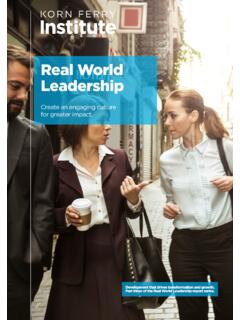Transcription of Real World Examples: The Community Preventive Services ...
1 The Community Preventive Services Task force s Built environment Recommendation to increase physical ActivityREAL- World EXAMPLES What is the recommendation from the Community Preventive Services Task force ?The Community Preventive Services Task force recommends built environment approaches that combine one or more interventions to improve transportation systems (activity-friendly routes) with one or more land use and Community design interventions (everyday destinations) to increase physical are combined built environment intervention approaches? Combined approaches that connect activity-friendly routes to everyday destinations make it safe and convenient for people of all abilities to walk, run, bike, skate, or use wheelchairs. Activity-Friendly RoutesPedestrian, Bicycle, and Transit Transportation Systems An activity-friendly route is one that is a direct and convenient connection with everyday destinations, offering physical protection from cars, and making it easy to cross the street.
2 Components to consider for intervention include: Street pattern design and connectivity Pedestrian infrastructure Bicycle infrastructure Public transit infrastructure and accessEveryday DestinationsLand Use and Environmental Design Everyday destinations are places people can get to from where they live by walking, bicycling, or public transit. This can include grocery stores, schools, worksites, libraries, parks, restaurants, cultural and natural landmarks, or healthcare facilities. They are often desirable, useful, and attractive. Components to consider for intervention include: Mixed land use Increased residential density Community or neighborhood proximity Parks and recreational facility accessHow do you combine these two categories?
3 There are many ways to implement this recommendation. The chart on the next page shows several real - World examples of combined built environment approaches. These examples illustrate how activity-friendly routes have been linked with everyday destinations in communities across the were these examples selected?The following chart includes examples from urban and rural locations in diverse parts of the country. Examples range from very simple, small-scale, low-cost built environment changes to more complex, large-scale, resource-intensive changes spanning entire communities. The green arrow to the left of the chart depicts this range. The chart illustrates how each example aligns with the new recommendation, but some have not been evaluated for their impact on physical activity, and none were included in the 90 studies that the Task force reviewed to develop the new recommendation.
4 The range of these examples offers every Community ideas for how it can start implementing combined approaches according to their setting, budget, and scale of much change in the built environment is enough to increase physical activity?The recommendation includes a small number of studies (12 out of 90) showing increases in physical activity associated with very small-scale interventions, such as crosswalks, traffic signals, or bike racks. However, the Task force did not specify a minimum threshold for the scale of change required to increase physical activity. Communities are encouraged to start where they can and then build toward larger scale improvements to increase physical more information about the Community Preventive Services Task force recommendation, visit and 284260-A December 2017 Activity-Friendly RoutesEveryday DestinationsReal- World ExampleStreet Pattern Design and ConnectivityPedestrian InfrastructureBicycle InfrastructurePublic Transit Infrastructure and AccessMixed Land UseIncreased Residential DensityProximity to Community DestinationsParks and Rec Facility AccessThe city of El Paso, TX created a walking route between the Union Plaza District and the Downtown Arts District.
5 These destinations of cultural and economic activity were previously divided by a locked parking lot that prohibited public and pedestrian access. A neighborhood in St. Louis, MO reduced average vehicle speed by using traffic calming techniques in a busy area served by four bus stops. This improved access to buses during the day, which connected residents to Community destinations. In Weslaco, TX, students, school officials, and the city public works department partnered to paint a new crosswalk to connect the school to the Community and the surrounding neighborhood. In Los Angeles, CA, the Watts neighborhood designed a visitor s center at the train station in a historic building along with a network of walking paths with public art to promote pedestrian traffic between the metrorail public transit stop and cultural sites.
6 With the mayor, more than 100 Community volunteers in Cuba, NM constructed or improved miles of trails with landscaping including shade trees, benches, parking areas, and signage. Each trail attracts different users two trails connect the village to the Santa Fe National Forest. The city of Hernando, MS obtained grant funding to revitalize an old road connecting the middle and high schools that had been blocked off for years. This new pathway opened a safe route to school and allows more residents to use a newly surfaced track. In Atlanta, GA, the BeltLine is converting abandoned railway into a combination of trails, parks, light rail transit, high-density residential buildings, and commercial development. Expected to eventually cover 22 miles of pathway, the BeltLine will connect 45 neighborhoods and Atlanta's council districts.
7 To improve public access to the waterfront in Houghton, MI, this remote city in the Upper Peninsula gradually acquired a stretch of shoreline property and replaced industrial ruins with parks, marinas, and paved bicycle/pedestrian trails which now connect the city center to parks and residential districts. Level of cost, complexity, or scaleFor more information about the Community Preventive Services Task force recommendation, visit and



















